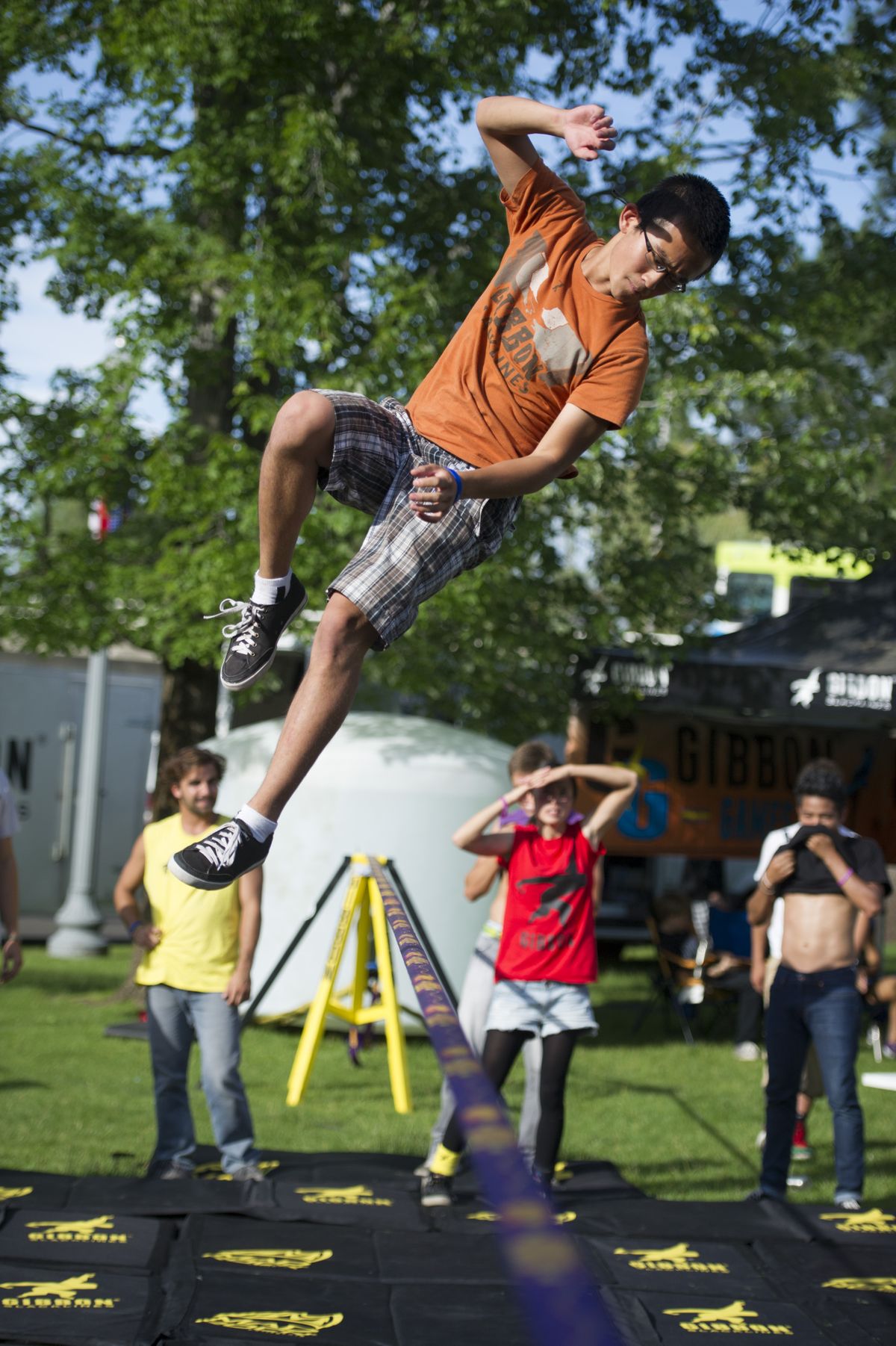Slacklining growing in popularity
From cross-training to rehabbing, tightropelike workouts benefit legs, core

But his sport has come far since that 2012 performance, Lewis said last week at Riverfront Park, where the World Cup of slacklining was taking place as part of Hoopfest.
Pounding music and an announcer’s play-by-play accompanied the bounces, flips and slips performed by Lewis and an international team of occasionally bloodied and bruised slackliners in front of an absorbed crowd. A few years ago, it would have been a lonelier scene, Lewis said: Just a guy on a line in a park. And after tens of millions of TV viewers witnessed those 30 seconds of acrobatics, he said, people are now more likely to ask “What, you haven’t heard of slacklining?” than “Slacklining, what’s that?”
What, you haven’t heard of slacklining?
There’s usually no loudspeaker, and the crowd is still more likely to amount to a few friends gathered around a line of flexible webbing strung between a couple of trees in a backyard or a park. But slacklining is coming into its own as an athletic pursuit.
“We’re shipping 50,000 slacklines a month now out of our facility in Colorado, where three years ago we were doing about 500 slacklines a month,” said Emilio Torres, a vice president at Gibbon Slacklines, an equipment maker and host of the weekend’s World Cup.
Because it strengthens core muscles and improves balance, slacklining is often used as a cross-trainer by rock climbers and other athletes. Climbers at Yosemite National Park get credit for its origins. Starting around the 1960s, they’d use downtime to string their webbing between trees, climb on and try not to fall off.
Petey Creighton, 60, manages the rock climbing department at Mountain Gear’s retail store. She said she picked up slacklining five summers ago. Now, for Creighton and her climbing friends, the slackline is a campsite fixture, strung between car bumpers or tow hitches.
“It’s low to the ground,” Creighton said. “You can make all kinds of mistakes – you can fall down, you’re not going to get hurt. But once you get it, you find that center of balance, it’s just a great learning tool.”
Anna Aho, 20, teaches an introductory slacklining class through Spokane’s Parks and Recreation department. After having trouble rebuilding strength in her knee after a soccer injury, she started slacklining two years ago on a friend’s suggestion.
Physical therapy got easier, she said.
“Slacklining really focuses on all the little muscles in your legs and body that you don’t really think about and use, or know how to strengthen,” said Aho, who’ll start classes at Eastern Washington University in the fall. “You work your ankles and hips a ton, because you’re balancing and countering your weight.”
Aho uses trees in her backyard to string up a line or pops over to nearby Corbin Park, a popular spot for slackliners. To protect the park’s old trees from damage, Aho said she avoids repeatedly using the same trees and wraps towels around the trunks before setting up her line.
“I’ve got my hops and my skips down, and I’m working on a couple of balance tricks now,” Aho said, including a sort of one-handed handstand on the line.
For beginners just learning to not fall off – more difficult than many expect, Aho said – she offers lots of tips, tricks and metaphors. It’s easier to balance on one foot than two, she tells them. Find the rhythm of the waves.
Slacklines are typically 1 or 2 inches wide. A wider line is more forgiving of a misplaced foot and feels tighter. It also makes “tricklining” – completing maneuvers such as spins, “butt bounces” and “chest bounces” – easier.
Along with its width, it’s the slack in the line that sets the sport apart from tightrope walking. The longer the line, the greater the slack and the more difficult it is to balance. Slackline kits come with a ratchet system that lets so-called slackers adjust the tension.
“If it’s looser, you have the tendency to either bounce or get a side-sway going,” Creighton said. While she’s a slacker who likes as little slack as possible, “Some people like to get a side-sway going because that’s really fun for them and they can control it. It’s like being on a unicycle – either you fall all the way over or you learn to balance in the middle.”
Creighton said she’s happy just to go back and forth, and she never wants to slackline much higher than 2 feet over the ground. “I’m working on trying to step backward, and I’m terrible at it,” she said.
Even without the butt bounces, though, slacklining offers a balance-boosting, muscle-toning good time, Creighton said – and it’s not age-specific: “If you can walk, you can slackline.”